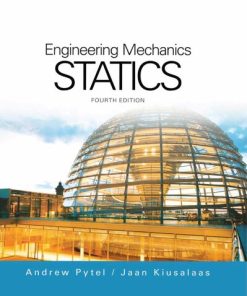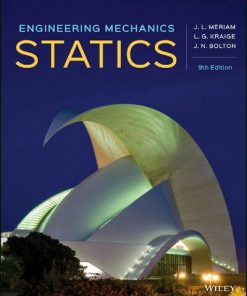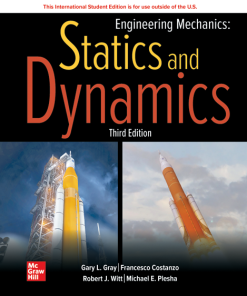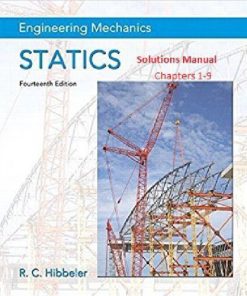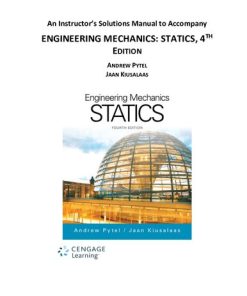Engineering Mechanics: Statics 14th Edition, (Ebook PDF)
$50.00 Original price was: $50.00.$25.00Current price is: $25.00.
Engineering Mechanics: Statics 14th Edition, (Ebook PDF) – Digital Instant Dowload.
Engineering Mechanics: Statics 14th Edition, (Ebook PDF) – Digital Instant Dowload.
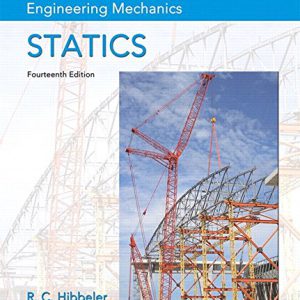
Product details:
- ISBN-10 : 0133918920
- ISBN-13 : 978-0133918922
- Author: R.C. Hibbeler
Engineering Mechanics: Statics excels in providing a clear and thorough presentation of the theory and application of engineering mechanics. Engineering Mechanics empowers students to succeed by drawing upon Professor Hibbeler’s everyday classroom experience and his knowledge of how students learn. This text is shaped by the comments and suggestions of hundreds of reviewers in the teaching profession, as well as many of the author’s students.
The Fourteenth Edition includes new Preliminary Problems, which are intended to help students develop conceptual understanding and build problem-solving skills. The text features a large variety of problems from a broad range of engineering disciplines, stressing practical, realistic situations encountered in professional practice, and having varying levels of difficulty.
Table contents:
1 General Principles 3
Chapter Objectives 3
1.1 Mechanics 3
1.2 Fundamental Concepts 4
1.3 Units of Measurement 7
1.4 T he International System of Units 9
1.5 Numerical Calculations 10
1.6 General Procedure for Analysis 12
2 Force Vectors 17
Chapter Objectives 17
2.1 Scalars and Vectors 17
2.2 Vector Operations 18
2.3 Vector Addition of Forces 20
2.4 Addition of a System of Coplanar Forces 32
2.5 C artesian Vectors 43
2.6 Addition of Cartesian Vectors 46
2.7 Position Vectors 56
2.8 Force Vector Directed Along a Line 59
2.9 Dot Product 69
3 Equilibrium of a Particle 85
Chapter Objectives 85
3.1 Condition for the Equilibrium of a Particle 85
3.2 The Free-Body Diagram 86
3.3 Coplanar Force Systems 89
3.4 Three-Dimensional Force Systems 103
4 Force System Resultants 117
Chapter Objectives 117
4.1 Moment of a Force—Scalar Formulation 117
4.2 Cross Product 121
4.3 Moment of a Force—Vector Formulation 124
4.4 Principle of Moments 128
4.5 Moment of a Force about a Specified Axis 139
4.6 Moment of a Couple 148
4.7 Simplification of a Force and Couple System 160
4.8 Further Simplification of a Force and Couple System 170
4.9 Reduction of a Simple Distributed Loading 183
5 Equilibrium of a Rigid Body 199
Chapter Objectives 199
5.1 Conditions for Rigid-Body Equilibrium 199
5.2 Free-Body Diagrams 201
5.3 Equations of Equilibrium 214
5.4 Two- and Three-Force Members 224
5.5 Free-Body Diagrams 237
5.6 Equations of Equilibrium 242
5.7 Constraints and Statical Determinacy 243
6 Structural Analysis 263
Chapter Objectives 263
6.1 Simple Trusses 263
6.2 The Method of Joints 266
6.3 Zero-Force Members 272
6.4 The Method of Sections 280
6.5 Space Trusses 290
6.6 Frames and Machines 294
7 Internal Forces 331
Chapter Objectives 331
7.1 Internal Loadings Developed in Structural Members 331
7.2 Shear and Moment Equations and Diagrams 347
7.3 Relations between Distributed Load, Shear, and Moment 356
7.4 Cables 367
8 Friction 389
Chapter Objectives 389
8.1 Characteristics of Dry Friction 389
8.2 Problems Involving Dry Friction 394
8.3 Wedges 416
8.4 Frictional Forces on Screws 418
8.5 Frictional Forces on Flat Belts 425
8.6 Frictional Forces on Collar Bearings, Pivot Bearings, and Disks 433
8.7 Frictional Forces on Journal Bearings 436
8.8 Rolling Resistance 438
9 Center of Gravity and Centroid 451
Chapter Objectives 451
9.1 Center of Gravity, Center of Mass, and the Centroid of a Body 451
9.2 Composite Bodies 474
9.3 Theorems of Pappus and Guldinus 488
9.4 Resultant of a General Distributed Loading 497
9.5 Fluid Pressure 498
10 Moments of Inertia 515
Chapter Objectives 515
10.1 Definition of Moments of Inertia for Areas 515
10.2 Parallel-Axis Theorem for an Area 516
10.3 Radius of Gyration of an Area 517
10.4 Moments of Inertia for Composite Areas 526
10.5 Product of Inertia for an Area 534
10.6 Moments of Inertia for an Area about Inclined Axes 538
10.7 Mohr’s Circle for Moments of Inertia 541
10.8 Mass Moment of Inertia 549
11 Virtual Work 567
Chapter Objectives 567
11.1 Definition of Work 567
11.2 Principle of Virtual Work 569
11.3 Principle of Virtual Work for a System of Connected Rigid Bodies 571
11.4 Conservative Forces 583
11.5 Potential Energy 584
11.6 Potential-Energy Criterion for Equilibrium 586
11.7 Stability of Equilibrium Configuration 587 Appendix
Contents
12 Kinematics of a Particle
12.1 Introduction
12.2 Rectilinear Kinematics: Continuous Motion
12.3 Rectilinear Kinematics: Erratic Motion
12.4 General Curvilinear Motion
12.5 Curvilinear Motion: Rectangular Components
12.6 Motion of a Projectile
12.7 Curvilinear Motion: Normal and Tangential Components
12.8 Curvilinear Motion: Cylindrical Components
12.9 Absolute Dependent Motion Analysis of Two Particles
12.10 Relative-Motion of Two Particles Using Translating Axes
13 Kinetics of a Particle: Force and
Acceleration
13.1 Newton’s Second Law of Motion
13.2 The Equation of Motion
13.3 Equation of Motion for a System
of Particles
13.4 Equations of Motion: Rectangular Coordinates
13.5 Equations of Motion: Normal
and Tangential Coordinates
13.6 Equations of Motion: Cylindrical Coordinates
*13.7 Central-Force Motion and Space Mechanics
14 Kinetics of a Particle: Work and
Energy
14.1 The Work of a Force
14.2 Principle of Work and Energy
14.3 Principle of Work and Energy for a System of Particles
14.4 Power and Efficiency
14.5 Conservative Forces and Potential Energy
14.6 Conservation of Energy
15 Kinetics of a Particle: Impulse
and Momentum
15.1 Principle of Linear Impulse and Momentum
15.2 Principle of Linear Impulse and Momentum for a System of Particles
15.3 Conservation of Linear Momentum for a System of Particles
15.4 Impact
15.5 Angular Momentum
15.6 Relation Between Moment of a Force and Angular Momentum
15.7 Principle of Angular Impulse and Momentum
15.8 Steady Flow of a Fluid Stream
*15.9 Propulsion with Variable Mass
16 Planar Kinematics of a Rigid
Body
16.1 Planar Rigid-Body Motion
16.2 Translation
16.3 Rotation about a Fixed Axis
16.4 Absolute Motion Analysis
16.5 Relative-Motion Analysis: Velocity
16.6 Instantaneous Center of Zero Velocity
16.7 Relative-Motion Analysis: Acceleration
16.8 Relative-Motion Analysis using Rotating Axes
17 Planar Kinetics of a Rigid Body:
Force and Acceleration
17.1 Mass Moment of Inertia
17.2 Planar Kinetic Equations of Motion
17.3 Equations of Motion: Translation
17.4 Equations of Motion: Rotation about a Fixed Axis
17.5 Equations of Motion: General Plane Motion
18 Planar Kinetics of a Rigid Body:
Work and Energy
18.1 Kinetic Energy
18.2 The Work of a Force
18.3 The Work of a Couple Moment
18.4 Principle of Work and Energy
18.5 Conservation of Energy
19 Planar Kinetics of a Rigid Body:
Impulse and Momentum
19.1 Linear and Angular Momentum
19.2 Principle of Impulse and Momentum
19.3 Conservation of Momentum
*19.4 Eccentric Impact
20 Three-Dimensional Kinematics of
a Rigid Body
20.1 Rotation About a Fixed Point
*20.2 The Time Derivative of a Vector Measured from Either a Fixed
or Translating-Rotating System
20.3 General Motion
*20.4 Relative-Motion Analysis Using Translating and Rotating Axes
21 Three-Dimensional Kinetics of a
Rigid Body
*21.1 Moments and Products of Inertia
21.2 Angular Momentum
21.3 Kinetic Energy
*21.4 Equations of Motion
*21.5 Gyroscopic Motion
21.6 Torque-Free Motion
22 Vibrations
*22.1 Undamped Free Vibration
*22.2 Energy Methods
*22.3 Undamped Forced Vibration
*22.4 Viscous Damped Free Vibration
*22.5 Viscous Damped Forced Vibration
*22.6 Electrical Circuit Analogs
A Mathematical Expressions
B Vector Analysis
C The Chain Rule
Fundamental Problems Partial
Solutions and Answers
You may also like…
Engineering - Mechanical Engineering & Dynamics
Engineering - Mechanical Engineering & Dynamics
Engineering Mechanics Statics 4th Edition by Andrew Pytel 8214342610 9798214342610
Engineering - Mechanical Engineering & Dynamics
Schaum’s Outline of Engineering Mechanics: Statics, 7th Edition Potter
Engineering - Engineering - General & Miscellaneous
Wiley Abridged Print Companion for Engineering Mechanics: Statics 9th Edition
Physics - Mechanics
Engineering Mechanics: Statics and Dynamics 3rd Edition Michael Plesha
Engineering - Mechanical Engineering & Dynamics
Engineering - Mechanical Engineering & Dynamics
Engineering Mechanics: statics, Instructor’s Solutions Manual 4th Edition Andrew Pytel






